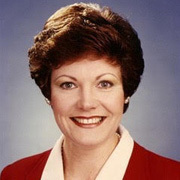
Jennie Goodwin
In 1965 Jennie Goodwin was a finalist in an Auckland beauty contest when she was approached to do a voice audition at television station AKTV-2. "Working as an announcer in radio and television was the last thing on my mind at the time."
A year later, aged 21, she moved from her job as a shorthand typist at radio station 1ZB to become a radio announcer and television continuity announcer at the NZ Broadcasting Corporation. Regular television broadcasts had only been going in Auckland for six years: there was no autocue, hair and makeup artists, or stylists.
“We used to come on at the beginning of the evening at 6pm and give a programme summary. We’d sit in a studio and the technicians would have a lovely bouquet of flowers behind us and fancy curtains. A lot of time was spent in decorating things to make it a formal lounge setting."
At this point only men were allowed to read the news on local television. Women announcers were "expected to add a touch of glamour," as she puts it. "A female newsreader was considered to have a light voice, lacking in authority and wouldn’t be able to convey 'serious' news to the viewing public."
Goodwin would find herself having to memorise several pages of programme introductions. Luckily she had a very good memory. Heavy makeup was necessary during the era of black and white, prompting her to wear false eyelashes and dark red lipstick.
In 1973, Goodwin was asked to model for the change over from black and white television to colour. “I’d have half my face made up with black and white makeup and the other half with regular makeup. I went down to Wellington and they all stood there with their pipes: 'oh yes, does this work, does that work?'"
Two years later, Goodwin got her big break. She was asked to audition for a role reading national news for Two at Seven on new channel TV2. In late June 1975 she made history, becoming the first woman in the Commonwealth to read the prime time national news bulletin (in 1973 Angela D'Audney had sparked debate about whether women should read the news, after being called on in an emergency to present one news bulletin). "At the time I don’t think I fully appreciated the reality of what I had achieved," says Goodwin. "It hasn’t been until many years later that I’ve thought about that honour. I'm rather proud of blazing the trail for future female newsreaders."
In both 1976 and 1980 the public voted her their favourite NZ Female Television Personality. Goodwin can be seen presenting the weather in this clip.
Many stories have passed through Goodwin's lips, but the November 1979 Air New Zealand crash on Mount Erebus remains the most emotionally difficult. All 237 passengers and 20 crew died in the Antarctica tragedy. “I will never forget how upsetting it was to read out the names of the deceased passengers and crew. All of New Zealand was grief-stricken and shell-shocked. Everyone seemed to know someone on that fateful flight.”
Another memorable moment saw the abandonment of a 1976 news bulletin 10 minutes early, after atrocious weather caused problems getting news footage on air in time for the bulletin. "There are only so many ways of apologising for the wrong footage being shown...I think there were more apologies from me than there were news stories that night. In the same situation today I'd probably have burst out laughing, but of course decorum was the rule of thumb in 1976."
Goodwin did her own hair/makeup and wardrobe throughout her TV career. She was paid $5 per newsreading shift to do so. "I have to admit it became a bit of a chore deciding what to wear...I always took pride in my appearance and it was more or less taken for granted that I would turn up each day suitably dressed and coiffed."
Goodwin left her job in 1976 to move to Britain for her husband's military career. She returned to TV2 two years later. In 1982 the couple moved to Singapore. She spent two years reading radio and TV news for Singapore Broadcasting, and also trained other newsreaders. At the age of 40, Goodwin was overjoyed to fall pregnant with daughter Virginia.
Around 1989, at age 44, Goodwin tried to make a comeback at TV3 and TVNZ. "Having been away from the game for seven to eight years, many others had filled the shoes I had left behind and it was hard to break in again. Plus I don’t think in those days they were interested in a woman of 44, whose presentation was of a more formal nature."
Goodwin returned to radio, newsreading for Today FM and Radio I. She also worked as a personal assistant.
But there was more television to come. In 2013 she presented a week's worth of episodes of TVNZ's Kiwi history series I Was There, as she looked back at the 1970s; earlier, in 2009, she returned to the newsdesk to read breakfast news on TV1's Breakfast, along with fellow news stalwarts Dougal Stevenson and Lindsay Perigo.
Goodwin — who is also known as Jennie Forder — was nervous before reading Breakfast news after so many years away, but the experience restored her confidence. "You just sit in the chair, with two minutes to flick through the stories before going live. It’s like riding a bike. The discipline just comes back and you do it."
Profile written by Natasha Harris
Sources include
Jennie Goodwin
'Jennie Goodwin: Pioneering female broadcaster...' (Video Interview), NZ On Screen website. Director Andrew Whiteside. Loaded 15 December 2014. Accessed 28 February 2018
Kelly Bertrand, 'Jennie and Judy: Pioneers Unite' ((Inteview) - The Australian Women's Weekly, 7 June 2013
Robert Boyd-Bell, New Zealand Television - The First 25 Years (Auckland: Reed Methuen Publishers, 1985)
David Gadd, 'Here, after many years, is the news, read by...' Stuff website. Loaded 26 November 2009. Accessed 28 February 2018